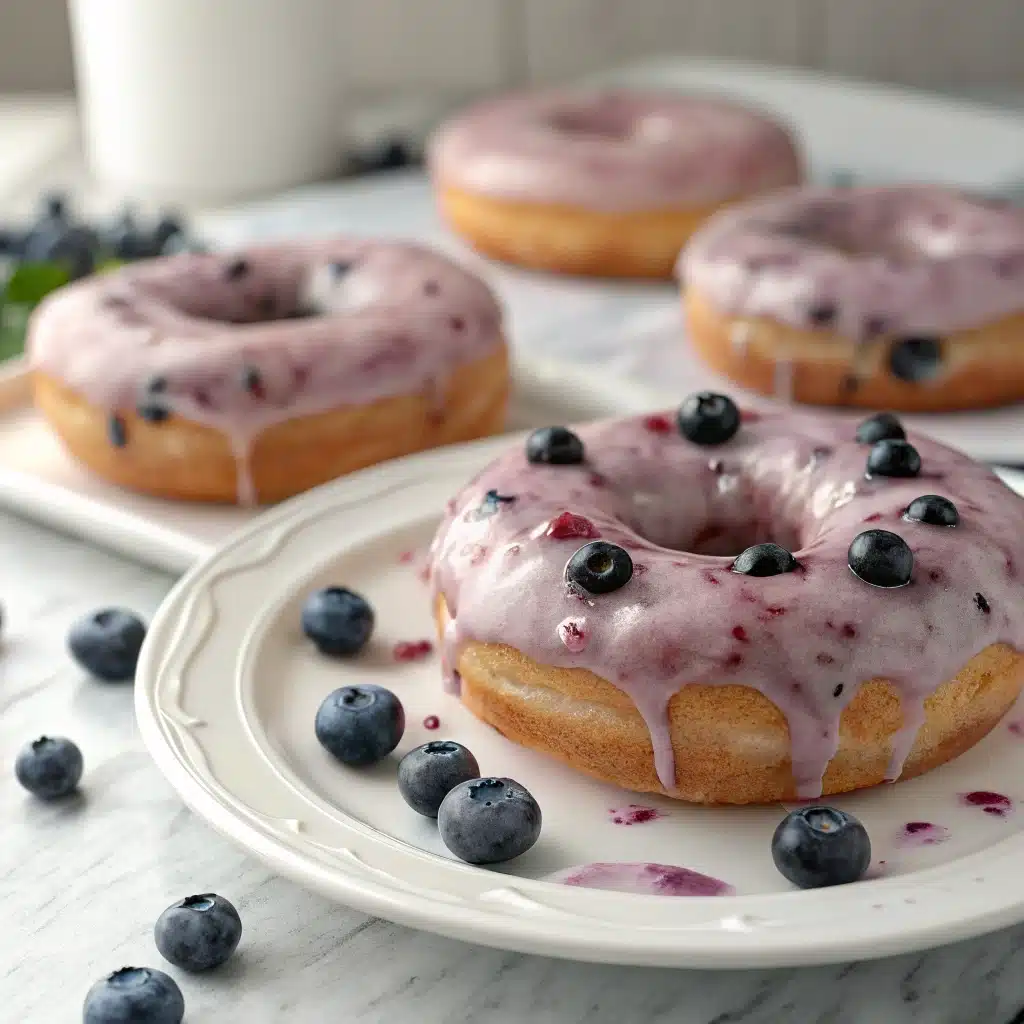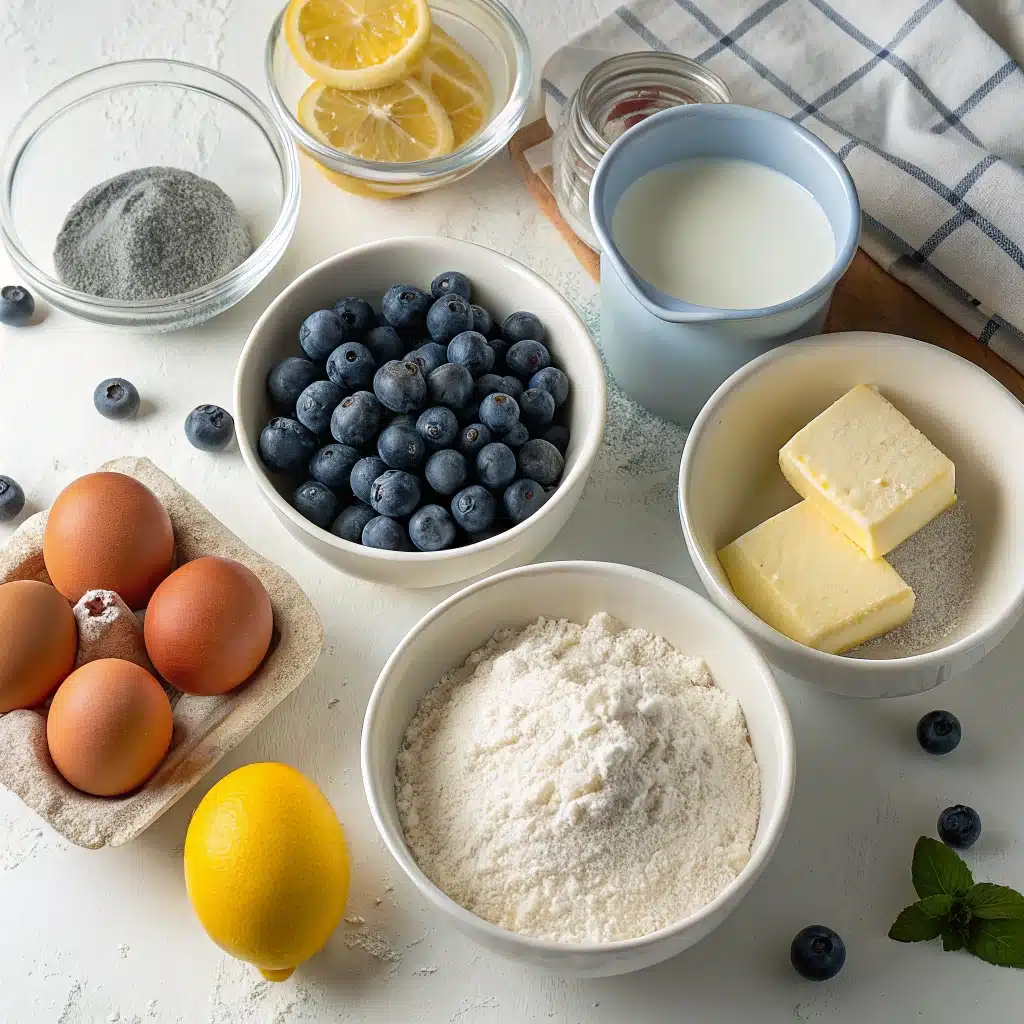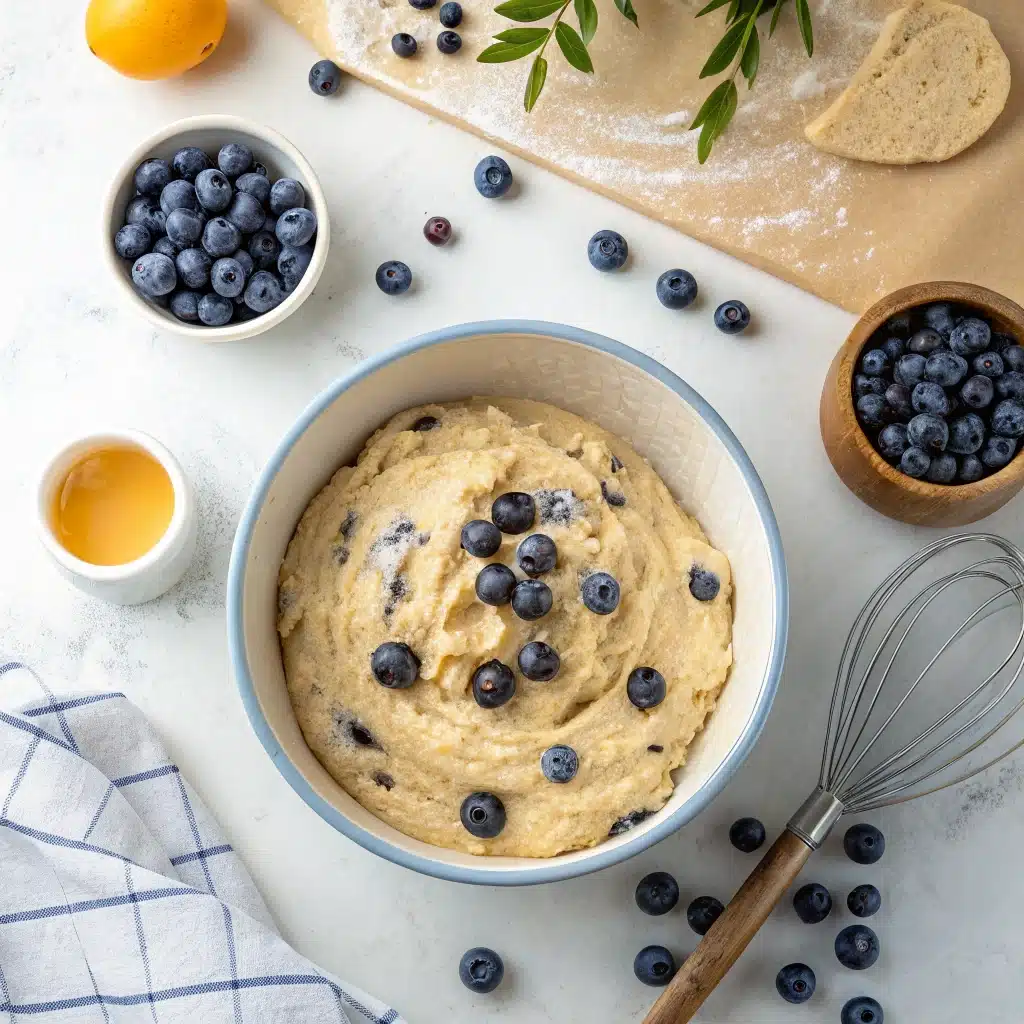Blueberry donuts are more than just a treat—they’re a memory, a tradition, and in my kitchen, a heartfelt ritual. I’m Mary, affectionately known as “The Pudding Lady” here in Bath. My baking journey began in my mother’s pantry, where flour dust danced through the air and the golden syrup lid was always glued shut. She believed that a good dessert could fix nearly anything—and I believed her.

But the real joy? Blueberry donuts. They’re tender, fluffy, and bursting with tangy-sweet blueberry flavor in every bite. Whether you like them fried or baked, glazed or sugared, there’s something magical about the way blueberries transform inside a warm dough pillow.
In this article, I’ll guide you through everything you need to know to create the most irresistible blueberry donuts—choosing the right ingredients, mastering proofing times, and learning why milk often beats water when it comes to flavor. You’ll also find out how to store them properly and why these beauties are so beloved in kitchens around the world.
Table of Contents
What Makes Blueberry Donuts Irresistible?
The Perfect Blend: Sweet Blueberries and Soft Dough
Blueberry donuts have a unique charm. The tartness of fresh or frozen blueberries cuts through the sweetness of the donut base, creating a balanced flavor profile that’s hard to beat. When the blueberries burst during baking or frying, they release juices that soak into the dough, adding extra moisture and natural flavor.
It’s not just about taste. The color contrast of golden dough with deep purple swirls from the berries makes blueberry donuts a feast for the eyes as well.
Blueberry Donuts vs. Traditional Donuts
So what sets blueberry donuts apart from standard glazed or chocolate donuts?
Here’s a quick comparison:
| Feature | Traditional Donuts | Blueberry Donuts |
|---|---|---|
| Flavor Base | Plain or vanilla | Infused with real blueberries |
| Texture | Fluffy or cakey | Moist with berry pockets |
| Popular Varieties | Glazed, Chocolate, Jelly | Baked, Lemon-blueberry, Glazed |
| Color Appeal | Golden or chocolate brown | Golden with berry swirls |
Compared to traditional donuts, blueberry donuts are often perceived as a fresher, lighter option—perfect for those who want sweetness with a fruity touch.
Why Are Blueberry Donuts So Good?
There’s science and sentiment behind it. First, blueberries are high in natural sugars and antioxidants, which create a satisfying bite that feels indulgent yet wholesome. The contrast between the slightly tart berry and the sweet dough keeps your taste buds intrigued. Add in a sugary glaze or a drizzle of lemon icing, and you’ve got layers of flavor and texture in every bite.
But it’s also about nostalgia—blueberry donuts often remind us of homemade baking, weekend markets, or special coffee shop treats. That emotional comfort adds to their irresistible quality.
Looking for inspiration? Try our lemon blueberry mini bundt cakes for a similar berry experience.
Ingredients and Tools You’ll Need

Choosing the Right Blueberries (Fresh, Frozen, or Dried?)
When making blueberry donuts, the type of blueberries you use can seriously affect the final taste and texture.
- Fresh Blueberries are ideal for their flavor and structure. They burst slightly during cooking, releasing just enough juice.
- Frozen Blueberries work well too, but be sure to thaw and drain them first to prevent sogginess.
- Dried Blueberries are less messy and concentrated in flavor, perfect if you want extra chewiness without excess moisture.
Each type has its advantages. For a classic, tender donut packed with juicy pops of fruit, nothing beats using fresh ingredients. If you’re baking off-season or want deeper flavor, try dried blueberries.
Discover great ideas like blueberry biscuits to explore other ways to use your berries.
Must-Have Ingredients for Blueberry Donuts
Here’s a quick look at the essential ingredients for crafting a timeless blueberry donut. These ingredients are typically pantry-friendly and easy to substitute if needed:
| Ingredient | Purpose | Substitutes |
|---|---|---|
| All-purpose flour | Base structure | Whole wheat (denser texture) |
| Sugar | Sweetness | Coconut sugar, maple syrup |
| Baking powder/soda | Leavening | Double-acting baking powder |
| Eggs | Richness and binding | Flaxseed or chia eggs (vegan) |
| Milk | Moisture and softness | Almond, oat, or soy milk |
| Butter or oil | Fat for tenderness | Coconut oil or vegan butter |
| Vanilla extract | Flavor enhancer | Almond or lemon extract |
| Blueberries | Star of the show | Fresh, frozen, or dried |
Optional:
- Lemon zest: enhances berry flavor
- Nutmeg or cinnamon: adds warmth
- Glaze ingredients: powdered sugar, milk, lemon juice
Don’t miss our blueberry crumble recipe for another berry-rich treat.
Essential Kitchen Tools and Alternatives
You don’t need a commercial kitchen to make delicious blueberry donuts. Here are some basic tools that help:
- Donut pan or mold (for baked version)
- Mixing bowls and spatula
- Electric hand mixer or whisk
- Piping bag or spoon (to fill molds evenly)
- Thermometer (for frying accuracy)
- Cooling rack (keeps the bottoms from getting soggy)
If you’re frying:
- Heavy-bottomed pot or fryer
- Slotted spoon or spider strainer
- Paper towels (for draining excess oil)
Tip: Looking for a cakey blueberry texture without frying? Try using a muffin tin with the center punched out. It works in a pinch!
Check out our mini blueberry bundt cakes for another delicious way to use your donut pan creatively.
Step-by-Step Recipe for Homemade Blueberry Donuts

Preparing the Dough: Mixing and Resting
Begin by assembling all your ingredients and setting up a clean, organized workspace. If you’re using fresh blueberries, rinse and gently pat them dry. If frozen, thaw and blot excess moisture.
Basic Blueberry Donut Dough:
- In a large bowl, whisk together:
- 2 cups all-purpose flour
- ½ cup granulated sugar
- 2 tsp baking powder
- ¼ tsp baking soda
- Pinch of salt
- In a separate bowl, mix:
- 2 eggs
- ½ cup milk (or buttermilk for tang)
- 2 tbsp melted butter or oil
- 1 tsp vanilla extract
- Gradually mix the wet and dry ingredients together, stirring gently until just combined. Do not overmix, or your donuts will become dense.
- Fold in 1 cup of blueberries gently. If using fresh ones, coat them lightly in flour before folding to help distribute them evenly.
- Let the batter rest for 10–15 minutes. This allows the gluten to rest, resulting in a softer, more tender texture.
Tip: Don’t miss our buttermilk donuts recipe for a tangy variation of this classic treat.
Print
Blueberry Donuts
- Total Time: 30 minutes
- Yield: 12 donuts 1x
- Diet: Vegetarian
Description
Soft, moist donuts bursting with blueberries and finished with a light glaze—baked or fried, they’re a fruity twist on a classic treat.
Ingredients
- 2 cups all-purpose flour
- 1/2 cup sugar
- 2 teaspoons baking powder
- 1/4 teaspoon baking soda
- 1/2 teaspoon salt
- 1/2 teaspoon cinnamon (optional)
- 2/3 cup buttermilk
- 2 large eggs
- 1/4 cup melted butter
- 1 teaspoon vanilla extract
- 1 cup fresh or frozen blueberries
- Glaze: 1 cup powdered sugar + 1–2 tablespoons milk
Instructions
- Preheat oven to 375°F (190°C) if baking, or heat oil to 350°F (175°C) if frying.
- In a large bowl, whisk together flour, sugar, baking powder, baking soda, salt, and cinnamon.
- In another bowl, whisk buttermilk, eggs, melted butter, and vanilla.
- Combine wet and dry ingredients just until mixed. Gently fold in blueberries.
- Spoon batter into greased donut pans or shape into rings for frying.
- Bake for 12–15 minutes or fry for 1–2 minutes per side until golden.
- Let cool slightly, then dip in glaze and allow to set before serving.
Notes
If using frozen blueberries, do not thaw. Add lemon zest to the glaze for a bright, tangy finish.
- Prep Time: 15 minutes
- Cook Time: 15 minutes
- Category: Breakfast
- Method: Baking or Frying
- Cuisine: American
Nutrition
- Serving Size: 1 donut
- Calories: 210
- Sugar: 14g
- Sodium: 190mg
- Fat: 8g
- Saturated Fat: 4g
- Unsaturated Fat: 3g
- Trans Fat: 0g
- Carbohydrates: 30g
- Fiber: 1g
- Protein: 3g
- Cholesterol: 35mg
Incorporating Blueberries Without Ruining Texture
Blueberries can release a lot of juice, which may turn your batter blue or make it soggy.
Here’s how to avoid that:
- Lightly toss the blueberries in flour before folding them in.
- Use a spatula, not a mixer, to prevent crushing the berries.
- Avoid over-stirring, which breaks the berries and stains the batter.
This step ensures you get clear blueberry pockets in every bite, not purple mush throughout.
Frying vs. Baking: What’s Best?
There are two main ways to cook blueberry donuts, and both have their pros and cons.
| Method | Texture | Health Factor | Equipment Needed |
|---|---|---|---|
| Fried | Crispy outside, fluffy inside | Less healthy (oil) | Pot, oil, thermometer |
| Baked | Soft and cakey | Healthier option | Donut pan, oven |
Frying Instructions:
- Heat oil in a deep pot to 350°F (175°C).
- Carefully pipe or spoon the dough into rings or mold-freehand.
- Fry for 1–2 minutes per side until golden brown.
- Drain on paper towels and glaze while warm.
Baking Instructions:
- Preheat oven to 375°F (190°C).
- Grease a donut pan and fill each cavity ¾ full.
- Bake for 12–14 minutes until springy and lightly browned.
Looking for a cake-donut style alternative? Don’t miss our blueberry crumble cheesecake, a thick and creamy cousin to this fried favorite.
Proofing and Frying Tips for Fluffy Donuts
How Long to Proof Donuts For?
Proofing is a critical step in creating fluffy, airy blueberry donuts. Whether you’re using yeast-based or baking powder-based dough, rest time matters.
For yeast donuts, proof the dough for about 60 to 90 minutes in a warm, draft-free spot until doubled in size. A gentle poke should leave a slight dent that gradually bounces back—signaling it’s ready.
For quick-bake donuts (using baking powder or soda), a short 10- to 15-minute rest after mixing helps the gluten relax and improves texture, even if it’s not a true proof.
Avoid over-proofing—it weakens the dough’s structure and makes it collapse during frying.
Ideal Temperature and Environment for Proofing
The perfect environment for proofing blueberry donuts is:
- Warm: around 75–85°F (24–29°C)
- Humid: use a damp towel over the bowl or place it in the oven with a cup of hot water nearby.
Avoid direct heat or air drafts. If your kitchen is cold, turn your oven to the lowest setting for 2 minutes, turn it off, and proof the dough inside.
Pro Tip: If you’re using a yeast recipe and proofing overnight, refrigerate the dough and bring it to room temperature before frying.
Frying Tips for Golden-Brown Blueberry Donuts
Frying donuts can be intimidating, but it’s easier than you think when done right.
Here’s your checklist for golden, fluffy blueberry donuts:
| Tip | Why It Matters |
|---|---|
| Use neutral oil (canola, sunflower) | Won’t affect donut flavor |
| Maintain oil temperature at 350°F | Prevents greasy or undercooked centers |
| Fry a few at a time | Keeps oil temp stable and donuts evenly cooked |
| Don’t flip too early | Let the first side set before turning |
| Drain properly | Use paper towels or a wire rack for crisp edges |
Want to level up? Add lemon zest to your glaze or toss freshly fried donuts in powdered sugar mixed with cinnamon.
Looking for inspiration? Try our blueberry crumble gluten-free for another berry-based bake that’s fluffy and satisfying.
Blueberry Donut Variations to Try
Glazed Blueberry Donuts
A classic blueberry donut wouldn’t be complete without a sweet, glossy glaze. The glaze not only adds sweetness but also helps seal in moisture, giving each bite a satisfying finish.
Basic Glaze Recipe:
- 1 cup powdered sugar
- 2–3 tablespoons milk (or lemon juice for tang)
- ½ teaspoon vanilla extract
Whisk ingredients until smooth. Dip cooled donuts into the glaze, then place on a wire rack to set.
Want a citrusy upgrade? Add lemon zest or swap in orange juice. Glazed blueberry donuts are crowd-pleasers and look bakery-perfect with minimal effort.
Lemon-Blueberry Donuts
Lemon and blueberry create a perfect flavor pairing—bright, tangy, and irresistibly balanced. The tart citrus brightens up the sweetness of the berries, creating a more complex and refreshing treat.
How to Make It:
- Mix in 1 tablespoon of lemon zest to infuse the batter with a fresh, citrusy kick
- Replace half the milk with fresh lemon juice
- Use a lemon glaze for extra zing
These are perfect for spring brunches or summer snacks. You’ll often find this combo in coffee shops, but it’s easy to recreate at home. Don’t miss our lemon blueberry mini bundt cakes for another citrus-packed dessert idea.
Vegan and Gluten-Free Options
No one should miss out on blueberry donuts—especially those with dietary restrictions. Here’s how to make them vegan or gluten-free (or both):
Vegan Swaps:
- Swap in almond, oat, or soy milk for a dairy-free alternative that keeps the batter smooth and flavorful
- Substitute eggs with flax eggs (1 tbsp ground flax + 3 tbsp water per egg)
- Replace butter with vegan butter or coconut oil
Gluten-Free Swaps:
- Use a 1:1 gluten-free flour blend
- Add ¼ tsp xanthan gum for elasticity (if not included in the blend)
These versions are just as moist and flavorful. You’ll get that soft, cakey bite without the allergens. For a fun twist, add shredded coconut or chia seeds to the batter for texture.
Craving more variations? Check out our blueberry crumble cheesecake—rich, creamy, and perfect for gluten-free indulgence.
Milk vs. Water: What’s the Best Liquid Base?
Are Donuts Better with Milk or Water?
One of the most common baking questions when making donuts—especially blueberry donuts—is whether to use milk or water in the dough.
Here’s the short answer: Milk makes better donuts.
Milk adds richness, fat, and a slightly sweet flavor that water simply can’t match. It also gives donuts a more tender crumb and helps them brown more evenly during baking or frying.
Water, on the other hand, will still get the job done, but the resulting donut might be a little drier and less flavorful. It’s useful if you’re out of milk or need a dairy-free option.
| Liquid Base | Texture Result | Flavor Boost | Best Used For |
|---|---|---|---|
| Milk | Soft, rich, tender | Yes | Traditional or baked donuts |
| Water | Slightly firmer | No | Dairy-free or budget baking |
For vegan versions, go with plant-based milk like almond, oat, or soy. These options preserve the moisture and rich flavor—minus the dairy.
The Science Behind Liquid Choices
Here’s why the liquid matters:
- Milk contains lactose (milk sugar), which helps with browning during frying or baking.
- Fats in milk contribute to moisture retention, giving your blueberry donuts that soft, cakey bite.
- Proteins in milk help strengthen the structure and trap air for fluffiness.
Water lacks all these components, which is why donuts made with water tend to be less rich.
Flavor and Texture Impact from Liquid Variations
Let’s break it down by how it affects both taste and texture:
- With milk: Blueberry flavors feel enhanced. The berries stay juicy inside a softer dough, and the exterior browns beautifully.
- With water: The donuts may feel lighter and slightly chewy but won’t have the full depth of flavor.
Pro Tip: If you’re using dried blueberries, milk can help rehydrate them slightly in the batter, making for a juicier final product.
Don’t miss our blueberry biscuits for another example of how liquid choice affects crumb and flavor in berry-based bakes.
Toppings and Fillings That Elevate Blueberry Donuts
Classic Sugar Glaze and Alternatives
A warm, freshly fried or baked blueberry donut is delicious on its own—but a perfect topping can take it to a whole new level.
The classic sugar glaze is always a favorite. It’s glossy, sweet, and helps lock in moisture.
Basic Sugar Glaze Recipe:
- 1 cup powdered sugar
- 2 tablespoons milk or lemon juice
- ½ teaspoon vanilla extract
Whisk until smooth. Dip cooled donuts halfway and let them set on a rack. For an extra burst of flavor, stir in lemon zest or replace half the milk with blueberry juice to create a vibrant blueberry glaze.
Other Glaze Alternatives:
- Cream cheese glaze (great with lemon blueberry donuts)
- Maple glaze for fall flavors
- Lavender glaze for a floral twist
- White chocolate drizzle for added richness
Glazes aren’t just pretty—they add flavor contrast and visual appeal that makes your donuts feel gourmet.
Blueberry Jam or Cream Cheese Filling
Want to impress your guests or take your donuts to the next level? Fill them.
Filled blueberry donuts are soft, luscious, and bursting with flavor. Here are two easy filling options:
1. Blueberry Jam Filling:
- Use a piping bag with a round tip
- Insert into the side of a fried donut
- Fill gently with homemade or store-bought blueberry jam
2. Cream Cheese Filling:
- Beat together 4 oz cream cheese, 2 tbsp sugar, and 1 tsp vanilla
- Pipe into the donut’s center for a tangy, creamy surprise
- Best paired with a berry glaze or powdered sugar topping
Filled donuts are ideal for special brunches or a dessert table spread. Want more creamy, fruity inspiration? Don’t miss our blueberry crumble cheesecake—a rich twist with similar flavors.
Creative Topping Ideas for Extra Flair
Looking to go beyond basic? Try some of these bold topping ideas for blueberry donuts that wow:
| Topping Idea | Flavor Profile | Pro Tip |
|---|---|---|
| Toasted coconut flakes | Nutty & crunchy | Sprinkle while glaze is wet |
| Lemon zest sugar | Bright & citrusy | Mix zest into granulated sugar |
| Crushed freeze-dried berries | Tart and colorful | Adds color and crunch |
| Crumbled graham crackers | Sweet & buttery | Perfect on cream cheese glaze |
| Blueberry powder drizzle | Fruity & vibrant | Blend dried berries into glaze |
Check out our mini blueberry bundt cakes for more topping inspiration using blueberries creatively.
How to Store and Keep Your Donuts Fresh
How to Store Blueberry Donuts?
Blueberry donuts taste best fresh, but with proper storage, they’ll stay soft and delicious for several days.
Here’s how to store them based on how soon you plan to enjoy them:
| Storage Method | Duration | Instructions |
|---|---|---|
| Room Temperature | 1–2 days | Store in airtight container or zip bag |
| Refrigerator | 3–5 days | Wrap individually or place in a covered box |
| Freezer | Up to 2 months | Wrap in plastic, then foil or freezer bag |
At Room Temperature:
Store them in a sealed container in a cool, dry spot. Line the bottom with a paper towel to absorb excess moisture and help preserve the glaze. Avoid stacking glazed donuts to prevent sticking.
In the Refrigerator:
Great for cream cheese-filled or jam-filled donuts. Be sure to wrap them tightly to lock in moisture and prevent them from drying out.
In the Freezer:
Place donuts on a tray and freeze for 30 minutes before transferring to a bag. This avoids clumping and helps maintain structure.
Want to enjoy them later? Follow these tips…
Freezing and Reheating Techniques
Blueberry donuts freeze surprisingly well—especially baked ones. Whether you’re batch prepping or saving leftovers, here’s how to reheat for that “just-made” freshness:
- To reheat from fridge: Microwave 10–12 seconds or warm in a 300°F oven for 5–6 minutes
- From freezer: Thaw at room temperature, then warm in the oven at 300°F for 8–10 minutes
Avoid microwaving frozen donuts directly, as this can make them soggy.
Want a pro tip? After reheating, toss plain donuts in cinnamon sugar or re-glaze for that fresh bakery shine.
Don’t miss our blueberry crumble recipe—it also stores and reheats beautifully, just like your favorite donut.
Preventing Sogginess and Staleness
No one likes a soggy donut. Here are a few tricks to avoid losing that delightful texture:
- Never store warm donuts—let them cool completely before boxing
- Avoid storing glazed and unglazed donuts together
- Re-glaze only when you’re ready to eat to keep them fresh longer
Want to elevate presentation for longer storage? Line containers with parchment and add a slice of fresh bread—it absorbs extra moisture without drying out the donuts.
Nutritional Information and Healthier Alternatives
Calorie Count and Nutritional Breakdown
Let’s face it—blueberry donuts aren’t exactly health food, but they can still fit into a balanced lifestyle when made with mindful ingredients and portion control.
Here’s an approximate breakdown for one medium-sized blueberry donut (glazed, fried):
| Nutrient | Amount |
|---|---|
| Calories | 250–300 kcal |
| Carbohydrates | 35–40 g |
| Sugar | 18–22 g |
| Fat | 12–16 g |
| Protein | 3–5 g |
| Fiber | 1–2 g |
Note: Baked versions contain 30–40% fewer calories and significantly less fat.
The use of real blueberries adds antioxidants, Vitamin C, and fiber, which make these donuts a slightly better choice than purely sugar-based treats.
How to Make Lighter Blueberry Donuts
You don’t have to give up flavor to make your blueberry donuts healthier. Just a few ingredient swaps can make a huge difference.
Smart Substitutions:
- Use Greek yogurt instead of sour cream or butter for moisture and added protein
- Swap out refined sugar for maple syrup or coconut sugar for a more natural, wholesome sweetness
- Use whole wheat pastry flour or almond flour for more fiber and nutrients
- Bake instead of fry to cut down on oil
- Use egg whites or flax eggs to reduce cholesterol or go plant-based
These adjustments can bring each donut down to around 180–200 calories—without sacrificing that soft, fruity bite.
Don’t miss our vegan pistachio cake for more plant-based dessert inspiration that doesn’t skimp on taste.
Swaps for Health-Conscious Bakers
If you’re baking for kids, diabetics, or fitness enthusiasts, here are a few extra tricks:
| Swap This | For This | Why It Works |
|---|---|---|
| Glaze | Greek yogurt drizzle | Tangy, protein-rich, and lower sugar |
| Whole milk | Almond or oat milk | Fewer calories, same moisture |
| All-purpose flour | Oat or almond flour | Higher fiber, fewer carbs |
| Frying | Air-frying or baking | Less fat, easier cleanup |
Bonus Tip: Add a scoop of protein powder to the dry ingredients and you’ve got a post-workout treat with benefits.
Conclusion
Blueberry donuts aren’t just a dessert—they’re a celebration of flavor, color, and comfort. From their naturally fruity bursts to the soft crumb and indulgent glazes, they bring joy whether fried or baked, classic or vegan. You now have everything you need to make the perfect blueberry donut at home—tips, tricks, toppings, variations, and even nutritional swaps.
Looking for more creative fruit bakes? Don’t miss our blueberry cornbread and blueberry biscuits to expand your berry-loving baking adventures.
Fore more recipes follow me in Facebook, medium and Pinterest
FAQs
Are doughnuts better hot or cold?
Most people agree: doughnuts are at their best when warm.
Fresh out of the fryer or oven, warm doughnuts have a tender, airy texture and that melt-in-your-mouth feel. The glaze is slightly runny, the inside is fluffy, and the aroma is unbeatable. That said, some folks prefer their donuts cool—especially those with rich fillings or thick coatings, which can set better and offer a firmer bite.
What makes a donut taste good?
A good donut is a perfect balance of texture, flavor, and freshness. Here’s what elevates a donut from average to unforgettable:
Freshness: A donut that’s made fresh (especially same-day) has unbeatable softness and aroma. Stale donuts lose their appeal quickly.
Proper Texture: Whether it’s a yeast-raised or cake donut, it should be light, slightly chewy, and not greasy. Frying at the right temperature and using the right flour makes a difference.
Flavor Balance: A touch of salt balances sweetness. High-quality vanilla, spices, citrus zest, or fresh fruit (like blueberries!) add complexity.
Moisture: Dry donuts are a no-go. A good donut has a moist interior without being soggy.
Glaze or Topping: The right topping (sugar glaze, powdered sugar, chocolate, lemon drizzle) complements the base without overpowering it.




